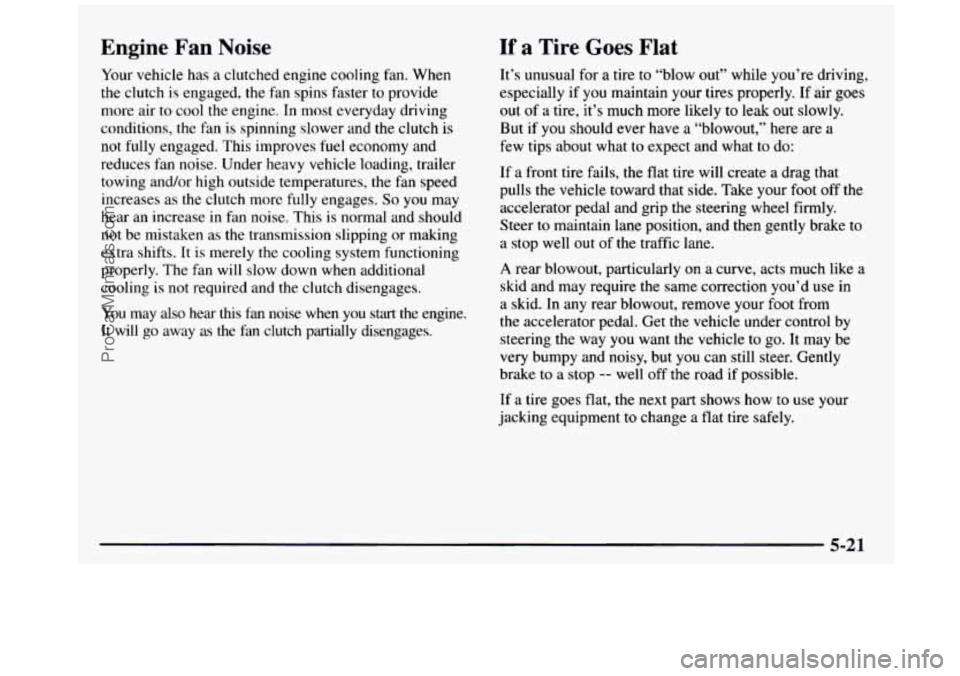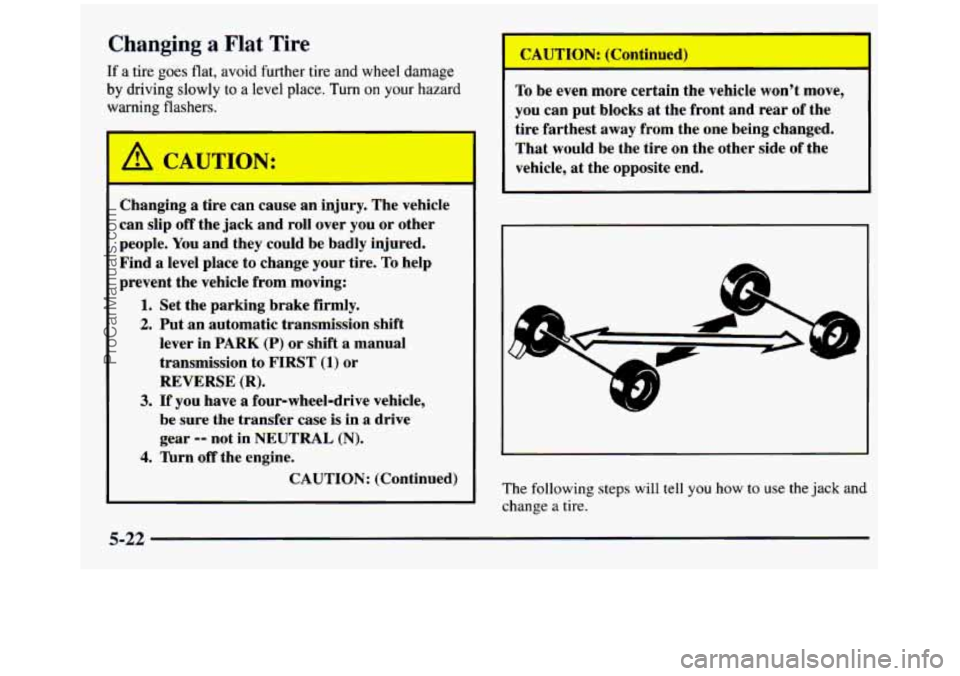Page 241 of 436
Section 5 Problems on the Road
Here you’ll find what to do about some problems that can occur on the road.
5-2
5-3
5-3
5-8
5-1 1
Hazard Warning Flashers
Other Warning Devices
Jump Starting
Towing Your Vehicle
Engine Overheating (Gasoline Engine) Cooling
System
-- Gasoline Engines
Engine Fan Noise
If a Tire
Goes Flat
Changing
a Flat Tire
If You’re Stuck: In Sand,
Mud, Ice or Snow
5- 13
5-2 1
5-2 1
5-22
5-34
5-11
ProCarManuals.com
Page 261 of 436

Engine Fan Noise
Your vehicle has a clutched engine cooling fan. When
the clutch is engaged, the fan spi.ns faster to provide
more air
to cool the engine. In most everyday driving
conditions, the fan is spinning slower and the clutch is
not fully engaged. This improves
fuel economy and
reduces fan noise. Under heavy vehicle loading, trailer towing and/or high outside temperatures, the fan speed
increases as the clutch more fully engages.
So you may
hear an increase in fan noise. This
is normal and should
not be mistaken as the transmission slipping or making
extra shifts. It is merely the cooling system functioning
properly. The fan will slow down when additional
cooling is not required and the clutch disengages.
You may also hear this
fan noise when you start the engine.
It will
go away as the fan clutch partially disengages.
If a Tire Goes Flat
It’s unusual for a tire to “blow out” while you’re driving,
especially
if you maintain your tires properly. If air goes
out
of a tire, it’s much more likely to leak out slowly.
But if you should ever have
a “blowout,” here are a
few tips about what to expect and what to do:
If a front tire fails, the flat tire will create a drag that
pulls the vehicle toward that side. Take your foot off the
accelerator pedal and grip the steering wheel firmly.
Steer to maintain lane position, and then gently brake to
a stop well out of the traffic lane.
A rear blowout, particularly on a curve, acts much like a
skid and may require the same correction you’d use in
a skid. In any rear blowout, remove your foot from
the accelerator pedal. Get the vehicle under control by
steering the way you want the vehicle to go. It may be
very bumpy and noisy, but
you can still steer. Gently
brake
to a stop -- well off the road if possible.
If a tire goes flat, the next part shows how to
use your
jacking equipment
to change a flat tire safely.
ProCarManuals.com
Page 262 of 436

Changing a Flat Tire
If a tire goes flat, avoid further tire and wheel damage
by driving slowly to a level place. Turn on your hazard
warning flashers.
I A CAUTION:
Changing a tire can cause an injury. The vehicle
can slip
off the jack and roll over you or other
people. You and they could be badly injured.
Find a level place
to change your tire. To help
prevent the vehicle from moving:
1. Set the parking brake firmly.
2. Put an automatic transmission shift
lever in
PARK (P) or shift a manual
transmission to
FIRST (1) or
REVERSE (R).
3. If you have a four-wheel-drive vehicle,
be
sure the transfer case is in a drive
gear
-- not in NEUTRAL (N).
4. Turn off the engine.
CAUTION: (Continued)
To be even more certain the vehicle won’t move,
you can put blocks at the front and rear of the
tire farthest away from the one being changed.
That would be the tire on the other side
of the
vehicle, at the opposite end.
The following steps will tell
you how to use the jack and
change
a tire.
5-22
ProCarManuals.com
Page 264 of 436
I Lower Raise
H
/1
A. Hoist Assembly
B. Ratchet
C. Jack Handle
D. Hoist Shaft
E. Valve Stem, Pointed
Down
E Spare Tire
G. Retainer
H. Hoist Cable Follow these
instructions to lower the spare tire:
1.
2.
3.
4.
One side of the ratchet has an UP marking. The other
side has a DOWN marking. Assemble the ratchet
to the hook near the end
of the jack handle (as
illustrated) with the
DOWN marking facing you.
Insert the, other end through the hole in the rear
bumper
and into the hoist shaft.
Turn the ratchet
to lower the spare tire. to the ground.
Continue to turn the ratchet until the spare tire can be
pulled out from under the vehicle.
When the tire has been lowered, tilt the retainer at
the end
of the cable so it can be pulled up through
the wheel opening,
Put the spare tire near the flat tire.
5-24
ProCarManuals.com
Page 265 of 436
The tools you'll be using include the jack (A), the jack
handle extension
(B), the jack handle (C), the wheel
wrench
(D) and the ratchet (E).
If the flat tire is on the rear of the vehicle, you'll need
the jack handle extension also.
- .'
. . .* ::*>:.,;,: , -.... ,.
Attach the jack handle (and jack handle extension, if
needed) to the jack.
5-25
ProCarManuals.com
Page 267 of 436
Removing the Flat Tire and Installing
the
Spare Tire
1 1. Use the ratchet and
wheel wrench to loosen
all the wheel nuts. Turn
the wheel wrench
counterclockwise, with
DOWN facing you, to
loosen the wheel nuts.
Don’t remove the wheel
nuts yet.
3
Front
Position
Rear
Position
2. Position the jack under the vehicle. If the flat tire is
on the front of the vehicle, position the jack on the
frame behind the flat tire. If the flat tire is on the
rear, position the jack on the rear axle between the
spring and the shock absorber.
I-
AC
Getting under a vehicle when it is jacked up is
dangerous. If the vehicle slips off the jack, you
could be badly injured or killed. Never get under
a vehicle when it is supported only by a jack.
NOTICE:
Raising your vehicle with the jack improperly
positioned will damage the vehicle or may allow
the vehicle to
fall off the jack. Be sure to fit the
jack lift head into the proper location before
raising your vehicle.
5-27
ProCarManuals.com
Page 268 of 436
Front Position Rear Position
3. With UP on the ratchet facing you, raise the vehicle
by rotating the ratchet and wheel wrench clockwise.
Raise the vehicle far enough off the ground
so there
is enough room for the spare tire to fit.
~ 4. Remove all the wheel
nuts
and take off the
flat tire.
5. Remove any rust or dirt
from the wheel
bolts,
mounting surfaces and
spare wheel.
5-28
ProCarManuals.com
Page 271 of 436
NOTICE:
Improperly tightened wheel nuts can lead to
brake pulsation and rotor damage.
To avoid
expensive brake repairs, evenly tighten the wheel
nuts in the proper sequence and
to the proper
torque specification.
9. Put the wheel trim back on. For vehicles with plastic
wheel nut caps, tighten the caps until they are finger
tight, then tighten them an additional one-half
TI
with the ratchet and wheel wrench.
Storing a Flat or Spare Tire and Tools
'A
Storing a jack, a tire or other equipment in the
passenger compartment
of the vehicle could
cause injury. In
a sudden stop or collision, loose
equipment could strike someone. Store all these
in the proper place.
Store the flat tire where the spare tire was stored.
5-31
ProCarManuals.com